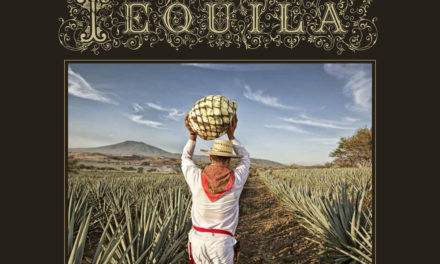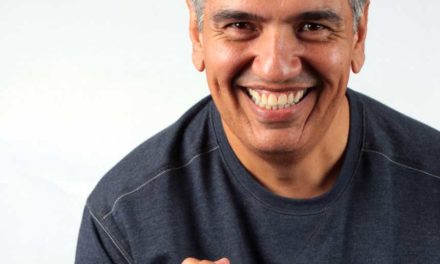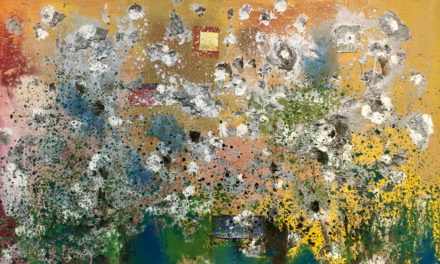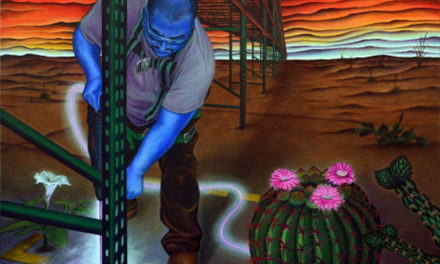Rudy Treviño came of age during the tumultuous 1960s era that revolutionized art, music, and culture in America. Treviño joined a new brand of Chicano artists who shared an irritation with conventional assimilation and accullturation models and assumptions. Chicano artists viewed themselves as rebels. They resisted traditional artistic norms, ranging from Renassiance painters to the predictable subjects of Norman Rockwell, which were commonly taught in universities. Treviño was a creative warrior in a new generation of Chicano artists who struck out on their own to define themselves and frame their own narrative.
Rudy R. Treviño, a San Antonio artist, led one of the new art movements that created the field of Chicano Art. Moreover, Treviño’s love of music helped him usher in the rise and popularity of Tejano music in Texas and beyond. As a teacher Treviño influenced Lanier High School students that ignited the Chicano muralism movement in San Antonio.
Treviño was born in the bordertown of Eagle Pass, Texas but moved to nearby Crystal City in the late 1950s. At age 12 he joined his family picking crops on the large agricultural farms surrounding the “Spinach Capital” of the world. Most of his classmates picked crops locally and also followed the harvest to the midwest often spending months in the beet fields of Wisconsin, Michigan, and Illinois. Treviño became one of the few who completed high school and attended college. In 1960, only 12.8 percent of Mexican Americans in areas of South Texas completed twelve years of school.
Treviño’s educational prospects improved in his early teens following his family’s move to San Antonio. His home on Flores Street, walking distance to Tech High School [Fox Tech] and San Pedro Springs, was one of the oldest neighborhoods of the city. Treviño loved art and demonstrated exceptional talents in meeting all the commercial art requirements at Fox Tech High School. At Fox Tech he was a classmate of Jesse Treviño who went on to become one the city’s most famous artists.
Rudy Treviño’s art abilities were so exceptional that he was offered a position a year after high school graduation to teach art at a local high school. He turned down the offer preferring to continue his studies at San Antonio College. However, the school district recruited him again the following year during his second year as a community college student offering him a full time post teaching commercial art and advertising classes at Lanier High School in the heart of San Antonio’s Westside. Treviño accepted the offer and the school district aranged an emergency teaching certificate for him.
While teaching at Lanier High School, Treviño continued his college studies at San Antonio College [SAC] where he studied under the virtuoso Maestro Mel Casas, an accomplished artist and highly regarded professor. Treviño recalled the many occasions when he joined his classmates at Casas’s home studio where the students were allowed to observe him while he painted. Casas mentored his SAC students well, and he also brought them together as he began to conceive of how Chicanos could create and mold their own art movement.
Treviño joined Casas early on as they founded Con Safo, one of the early Chicano art organizations in the nation. Treviño followed Mel Casas as President of Con Safo. The artists met weekly, and Treviño is credited for bringing the group together to meet the prominent Chicano author, Dr. Tomas Rivera. Rivera had taken an academic post at UTSA in 1971 and attended some of the Con Safo meetings. Rivera also volunteered to write grant proposals that enabled the newly organized artist group to exhibit in several cities in Texas and the Midwest.
After completing art classes at SAC, Treviño enrolled at the University of Texas at Austin. At Austin he met Dr. Jacinto Quirate, an Associate Professor of Art History who had just begun to interview Mexican American artists from across the country. Quirate had extensive discussions with Mel Casas and Rudy Treviño in 1970 and also attended several meetings of the Con Safo group.
Quirate’s research resulted in the publication of the pioneering book Mexican American Artists in 1973. Quirate interviewed some of the Con Safo artists and wrote a section in the book on Rudy Treviño and Amado Peña. The author included images of two acrylic paintings and a lithographic by Treviño noting that the artist had “meticulously painted in Mel Casas fashion, a head of blonde hair” added to a painting titled “There.” Quirate’s book appeared as he completed plans to move to San Antonio. Dr. Rivera, a Vice President at UTSA and friend of the Con Safo artists, recruited Quirate to head the new College of Fine and Applied Arts [CFAA] at UTSA.
In the mid 1970s the Con Safo group disbanded, and Treviño became the editor and publisher of Picante magazine, a Latino magazine dedicated to art, poetry, music, fashion, and politics. In 1977 Treviño enrolled in the Masters’ program in Fine Arts at UTSA where his friend Quirate served as Dean. Treviño continued to teach at Lanier High School full time while he took graduate classes at UTSA and painted. His creative and productive art series was selected for the 1979 art exhibition, “Ancient Roots, New Visions.” The exhibit traveled to Latin American and Europe and was one of the first Chicano art shows to tour outside of the United States.
Treviño taught and mentored many outstanding students at Lanier High School, among them Anastacio Torres and Juan Hernandez, co-founders of the city’s first major mural movement. Torres and Hernandez, with the assistance of Treviño, founded the Community Cultural Arts [CCA] program that recruited young artists to paint murals at Cassiano Homes.Treviño served as the Board President and assisted the young artists as they submitted grant requests to the City of San Antonio. Among the mural art recruits were Alex Rubio and Vincent Valdez, two of San Antonio’s best known artists today. Over the period 1979-1985, the CCA group painted nearly 100 murals, mostly in the Westside of the city.
In 1985, Treviño, who was also co-founder of the Tejano Music Awards, was in a bind. He needed a band for the opening act of the awards ceremonies, but several well-known musicians preferred the more prestigious spot at the event closing. Treviño decided to take a chance on
an up-and-coming South Texas 14-year-old singer by the name of Selena whom he had heard in several small music venues. Selena was a big hit that night and returned two years later to receive awards as the top Tejana vocalist as well as awards for best song and best album. Historian Cynthia Orozco wrote that “her [Selena’s] popularity soared with annual awards from the Tejano Music Awards.”
A Centro De Artes tribute in San Antonio to “Los Maestros: Early Explorers of Chicano Idenity” in 2020 featured the work of Jesse A. Almanzan, Jose Esquivel, and Rudy R. Treviño. Author Dr. Ann Marie Leimer commented that the three Maestros, “have produced powerful bodies of work that reflect the experiences of Chicana and Chicano communities, that critique and challenge racist and hegemonic power structures, that transform the way we see our world, and that affirm the human spirit.”
The Centro De Artes exhibit gave viewers a sample of Treviño’s fifty year contribution to Chicano art. It is evident, however, that Treviño’s personal endowment to the arts in Texas and beyond also included teaching, mentoring, and publishing, as well as initiating important recognition for performers in the Latino music world. Rudy Treviño is a towering figure among those early founders of the Chicano art and music movement
An Art Rebel with a Cause: Rudy Treviño and The Chicano Art Movement












